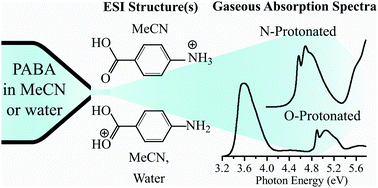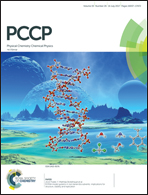Experiment and theory confirm that UV laser photodissociation spectroscopy can distinguish protomers formed via electrospray†
Abstract
The identification of protonation sites in electrosprayed molecules remains a challenge in contemporary physical science. We present the first demonstration that low-resolution, UV laser photodissociation spectroscopy can be applied in situ to identify the protomers of para-aminobenzoic acid (PABA) formed via electrospray from a single solution. Electronic absorption spectra are recorded via photodepletion and photofragmentation for PABA electrosprayed from solutions of water and acetonitrile. Using this approach, two protomers can be straightforwardly identified, with only the carboxylic acid protomer being produced on electrospray from water while the amine-protonated isomer dominates upon electrospray from acetonitrile. High-level SORCI and MRCI calculations are presented to provide insight into the origin of the distinctive electronic spectra displayed by the protomers. Our results are in excellent agreement with previous PABA studies conducted using established techniques, and demonstrate that UV photodissociation spectroscopy of electrosprayed ions has potential as a new diagnostic tool for identifying protomeric species.



 Please wait while we load your content...
Please wait while we load your content...